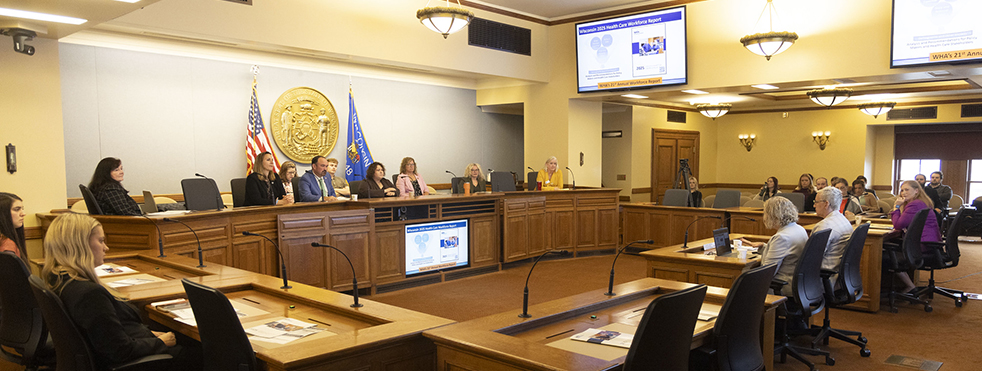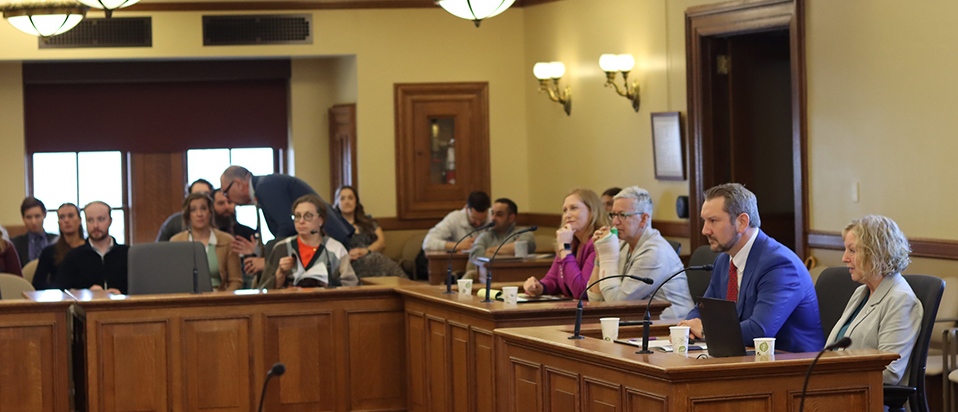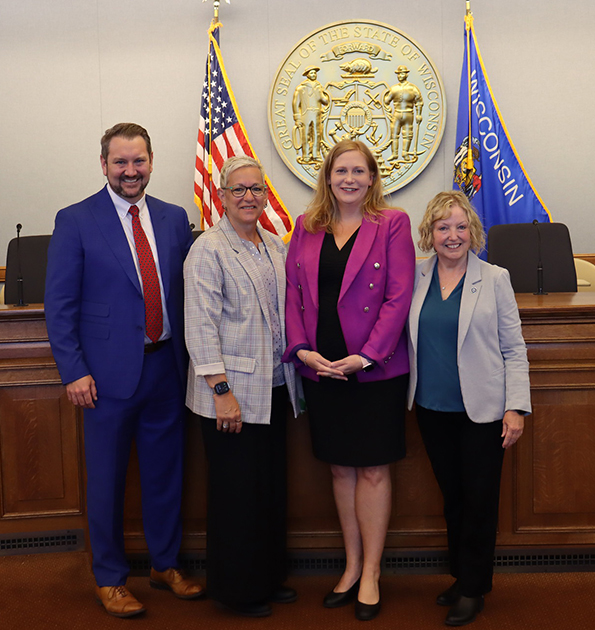Click here to view past issues
IN THIS ISSUE
- WHA Presents State Capitol Briefing on 2025 Health Care Workforce Report
- WHA Testimony Highlights Importance of Reducing Complexity in Child Mental Health Laws
- WHA's Wisconsin Rural Health Conference is NEXT WEEK!
- Register for WHA’s Financial Workshop
- Peer Support in Wisconsin Hospitals – We Want Your Input!
EDUCATION EVENTS
Dec. 16, 2025
Common Hospital DeficienciesJan. 14, 2026
Caring for Wisconsin’s Caregivers Well-Being First Champion Challenge for Credentialing KickoffJan. 28, 2026
2026 WHA Health Care Leadership AcademyClick here to view education event calendar
View more issues of The Valued Voice
Sign Up for WHA's Newsletter
WHA Presents State Capitol Briefing on 2025 Health Care Workforce Report
Hospital leaders join O’Brien and Zenk to highlight challenges and offer solutions
The chairs and ranking members of the Wisconsin Legislature’s Senate Committee on Health and the Assembly Committee on Health, Aging and Long-Term Care hosted a Wisconsin Hospital Association (WHA) workforce legislative briefing for state policymakers and staff May 21, 2025 at the state capitol in Madison, streamed live on WisconsinEye.
 WHA's health care workforce briefing at the state capitol on May 21, 2025
WHA's health care workforce briefing at the state capitol on May 21, 2025
WHA Senior Vice President of Government Relations Kyle O’Brien and Senior Vice President of Workforce and Clinical Practice Ann Zenk shared findings and recommendations from the WHA 2025 Wisconsin Health Care Workforce Report. Western Wisconsin Health CEO Eilidh Pederson and Beloit Health System Chief Nursing Officer Sharon Cox joined O’Brien and Zenk and provided real-world examples of the challenges they face, how WHA members are growing, supporting and sustaining their own workforce, and how the tools and resources provided by the state Legislature have assisted in those efforts.
 At right are Eilidh Pederson, Sharon Cox, Kyle O'Brien and Ann Zenk.
At right are Eilidh Pederson, Sharon Cox, Kyle O'Brien and Ann Zenk.
State Sens. Rachael Cabral-Guevara and Jeff Smith and State Reps. Clint Moses and Lisa Subeck invited state legislators and legislative staff to join them to discuss the issues facing health care and the health care workforce. More importantly, legislators and their staff heard about solutions and how sound health care policy strengthens the health care workforce and assists policymakers in addressing current and future health care needs.
Subeck opened the briefing, noting, “It’s no secret that we face workforce challenges in our health care field.” Rep. Subeck encouraged her colleagues to reach out to WHA, saying “WHA and this report puts us in a better position to address these challenges.”
O’Brien provided an overview of the environment and challenges confronting Wisconsin hospitals and health systems and their workforce. He noted that WHA’s workforce report has become a relied-upon guide for policymakers and industry stakeholders and a catalyst for public policy changes that support health care and the health care workforce. O’Brien recognized the value of the Legislature’s much-appreciated partnership in key workforce policy that helps improve health care in Wisconsin: “Thank you for being here, and for everything we have done together; let’s keep going.”
O’Brien highlighted for legislators and their staff key WHA resources beyond WHA’s annual workforce report—the WHA Information Center’s Price Finder and CheckPoint sites that demonstrate WHA’s and WHA members’ long-term commitment to quality and transparency.
Zenk also thanked the Legislature for their expertise, partnership and support and explained how demographics and the “Silver Tsunami,” as the aging of the very large baby boom generation has been termed, are simultaneously increasing health care demand and shrinking the available workforce. WHA’s workforce expert noted “Demographics are largely beyond our control, but we can partner on the things within our control. We can help grow the workforce faster and help the workforce we have work to their full potential, relieved of regulatory burden wherever possible.”
 L to R: Kyle O'Brien, Sharon Cox, Eilidh Pederson and Ann Zenk.
L to R: Kyle O'Brien, Sharon Cox, Eilidh Pederson and Ann Zenk.
Zenk reviewed key data from the report and highlighted key accomplishments made together, such as the in-migration of more physicians to Wisconsin from other states than are leaving Wisconsin for other states, facilitated by Wisconsin’s high quality of care, which attracts high-quality health care professionals and by Wisconsin’s balanced liability environment. She then turned it over to Sharon Cox to provide real-world examples of how Beloit Health System is rising to the challenge of demographic and payer shifts, financial headwinds and workforce challenges.
Cox noted that Wisconsin’s balanced liability environment provides an advantage for Beloit over their neighbors in Illinois, and thanked legislators for 2021 Act 10 which breaks down licensure barriers, especially for hospitals on the border of other states. She also shared the key partnerships with their school system, Blackhawk Technical College and Beloit College, that are helping grow their workforce faster, but not fast enough.
Zenk followed with an update on the very successful “Grow Our Own” grant program and thanked the state’s legislators for all they have done to fund the program and keep it up to date, noting “The GME, Allied Health and Advanced Practice Clinician grants have resulted in a $100 million public-private investment in our health care workforce.”
Pederson echoed Zenk’s appreciation and showed legislators how this grow-from-within investment is being utilized at her hospital and clinics. She also noted the real-life impacts if hospitals and health systems don’t sustain their health care workforce. Pederson asked legislators to keep helping by sustaining Grow Our Own funding, increasing Medicaid reimbursement and helping rein in ever-growing payer demands.
Zenk closed out the briefing by noting, “Expanding educational capacity and creating more training opportunities is important.” Zenk described the success of WHA’s “So Many Options” health care career promotion social media campaign and website, saying “We’ve asked students to pursue health care careers, and they’ve responded. Now we have to make sure there’s a seat for them in the classroom.”
You can find more information about Wisconsin’s health care workforce and WHA’s recommendation on WHA's Workforce Report webpage. Reach out to Ann Zenk with questions or ideas regarding the health care workforce or WHA’s 2025 Wisconsin Health Care Workforce Report.
WHA Presents State Capitol Briefing on 2025 Health Care Workforce Report
Hospital leaders join O’Brien and Zenk to highlight challenges and offer solutions
The chairs and ranking members of the Wisconsin Legislature’s Senate Committee on Health and the Assembly Committee on Health, Aging and Long-Term Care hosted a Wisconsin Hospital Association (WHA) workforce legislative briefing for state policymakers and staff May 21, 2025 at the state capitol in Madison, streamed live on WisconsinEye.
 WHA's health care workforce briefing at the state capitol on May 21, 2025
WHA's health care workforce briefing at the state capitol on May 21, 2025
WHA Senior Vice President of Government Relations Kyle O’Brien and Senior Vice President of Workforce and Clinical Practice Ann Zenk shared findings and recommendations from the WHA 2025 Wisconsin Health Care Workforce Report. Western Wisconsin Health CEO Eilidh Pederson and Beloit Health System Chief Nursing Officer Sharon Cox joined O’Brien and Zenk and provided real-world examples of the challenges they face, how WHA members are growing, supporting and sustaining their own workforce, and how the tools and resources provided by the state Legislature have assisted in those efforts.
 At right are Eilidh Pederson, Sharon Cox, Kyle O'Brien and Ann Zenk.
At right are Eilidh Pederson, Sharon Cox, Kyle O'Brien and Ann Zenk.
State Sens. Rachael Cabral-Guevara and Jeff Smith and State Reps. Clint Moses and Lisa Subeck invited state legislators and legislative staff to join them to discuss the issues facing health care and the health care workforce. More importantly, legislators and their staff heard about solutions and how sound health care policy strengthens the health care workforce and assists policymakers in addressing current and future health care needs.
Subeck opened the briefing, noting, “It’s no secret that we face workforce challenges in our health care field.” Rep. Subeck encouraged her colleagues to reach out to WHA, saying “WHA and this report puts us in a better position to address these challenges.”
O’Brien provided an overview of the environment and challenges confronting Wisconsin hospitals and health systems and their workforce. He noted that WHA’s workforce report has become a relied-upon guide for policymakers and industry stakeholders and a catalyst for public policy changes that support health care and the health care workforce. O’Brien recognized the value of the Legislature’s much-appreciated partnership in key workforce policy that helps improve health care in Wisconsin: “Thank you for being here, and for everything we have done together; let’s keep going.”
O’Brien highlighted for legislators and their staff key WHA resources beyond WHA’s annual workforce report—the WHA Information Center’s Price Finder and CheckPoint sites that demonstrate WHA’s and WHA members’ long-term commitment to quality and transparency.
Zenk also thanked the Legislature for their expertise, partnership and support and explained how demographics and the “Silver Tsunami,” as the aging of the very large baby boom generation has been termed, are simultaneously increasing health care demand and shrinking the available workforce. WHA’s workforce expert noted “Demographics are largely beyond our control, but we can partner on the things within our control. We can help grow the workforce faster and help the workforce we have work to their full potential, relieved of regulatory burden wherever possible.”
 L to R: Kyle O'Brien, Sharon Cox, Eilidh Pederson and Ann Zenk.
L to R: Kyle O'Brien, Sharon Cox, Eilidh Pederson and Ann Zenk.
Zenk reviewed key data from the report and highlighted key accomplishments made together, such as the in-migration of more physicians to Wisconsin from other states than are leaving Wisconsin for other states, facilitated by Wisconsin’s high quality of care, which attracts high-quality health care professionals and by Wisconsin’s balanced liability environment. She then turned it over to Sharon Cox to provide real-world examples of how Beloit Health System is rising to the challenge of demographic and payer shifts, financial headwinds and workforce challenges.
Cox noted that Wisconsin’s balanced liability environment provides an advantage for Beloit over their neighbors in Illinois, and thanked legislators for 2021 Act 10 which breaks down licensure barriers, especially for hospitals on the border of other states. She also shared the key partnerships with their school system, Blackhawk Technical College and Beloit College, that are helping grow their workforce faster, but not fast enough.
Zenk followed with an update on the very successful “Grow Our Own” grant program and thanked the state’s legislators for all they have done to fund the program and keep it up to date, noting “The GME, Allied Health and Advanced Practice Clinician grants have resulted in a $100 million public-private investment in our health care workforce.”
Pederson echoed Zenk’s appreciation and showed legislators how this grow-from-within investment is being utilized at her hospital and clinics. She also noted the real-life impacts if hospitals and health systems don’t sustain their health care workforce. Pederson asked legislators to keep helping by sustaining Grow Our Own funding, increasing Medicaid reimbursement and helping rein in ever-growing payer demands.
Zenk closed out the briefing by noting, “Expanding educational capacity and creating more training opportunities is important.” Zenk described the success of WHA’s “So Many Options” health care career promotion social media campaign and website, saying “We’ve asked students to pursue health care careers, and they’ve responded. Now we have to make sure there’s a seat for them in the classroom.”
You can find more information about Wisconsin’s health care workforce and WHA’s recommendation on WHA's Workforce Report webpage. Reach out to Ann Zenk with questions or ideas regarding the health care workforce or WHA’s 2025 Wisconsin Health Care Workforce Report.
IN THIS ISSUE
- WHA Presents State Capitol Briefing on 2025 Health Care Workforce Report
- WHA Testimony Highlights Importance of Reducing Complexity in Child Mental Health Laws
- WHA's Wisconsin Rural Health Conference is NEXT WEEK!
- Register for WHA’s Financial Workshop
- Peer Support in Wisconsin Hospitals – We Want Your Input!

